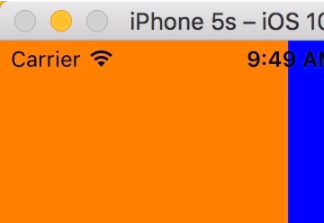什么是iBeacon?
iBeacon 是苹果公司2013年9月发布的移动设备用OS(iOS7)上配备的新功能。其工作方式是,配备有低功耗蓝牙(BLE)通信功能的设备使用BLE技术向周围发送自己特有的 ID,接收到该 ID 的应用软件会根据该 ID 采取一些行动。
从个人的角度看: iBeacon向四面八方不停地广播信号,就像是往平静的水面上扔了一块石子,泛起层层涟漪(俗称水波),波峰相当于 iBeacon 的RSSI(接受信号强度指示),越靠近中心点的地方波峰越高(RSSI 越大),这个波峰的大小(RSSI 的值)受到扔石子时用力大小(发射功率)和水质(周围环境因子)的影响,离中心点越远水波越趋向于平静,超过了一定值,水波会消失于无形,也就是说 iBeacon 向外广播的距离是有范围的,超过了这个范围,将接受不到 iBeacon 的信号。
从iOS开发者的角度看: iBeacon 在 CoreLocation 框架中抽象为CLBeacon类, 该类有6个属性,分别是:
|
1
2
3
4
5
6
|
typedef NS_ENUM(NSInteger, CLProximity) { CLProximityUnknown,// 无效 CLProximityImmediate,//在几厘米内 CLProximityNear,//在几米内 CLProximityFar//超过 10 米以外,不过在测试中超不过10米就是far} |
-
proximityUUID,是一个NSUUID,用来标识公司。每个公司、组织使用的 iBeacon 应该拥有同样的proximityUUID。 -
major,主要值,用来识别一组相关联的 beacon,例如在连锁超市的场景中,每个分店的 beacon 应该拥有同样的major。 -
minor,次要值,则用来区分某个特定的 beacon。 -
proximity,远近范围的,一个枚举值。 -
accuracy,与iBeacon的距离。 -
rssi,信号轻度为负值,越接近0信号越强,等于0时无法获取信号强度。
Tip:proximityUUID,major,minor 这三个属性组成 iBeacon 的唯一标识符。
只要进入iBeacon的范围,就能唤醒 App(大约10秒钟),即使在程序被杀掉的情况下。必要时,可以使用UIApplication类的- (UIBackgroundTaskIdentifier)beginBackgroundTaskWithExpirationHandler:(void (^)(void))handler;方法,请求更多的后台执行时间。
iBeacon的用途:我们可以用iBeacon可以进行室内定位(车库,商场),智能打卡,提醒(离开某物体的时候,比如离开家)。
iBeacon 与 BLE 的区别
iOS 中 iBeacon 是基于地理位置的微定位技术,虽然借助手机蓝牙进行接收Majro、Minor,但是他们在开发工程中没有任何关系。
iBeacon使用苹果提供CoreLocation库,然而在 BLE 在开发过程中使用CoreBluetooth库。从上面提供的库来看就很清楚了,特别是在 iOS8.0 之后的时候如果想使用iBeacon,必须让用户点击是否允许XXapp使用地理位置。如果在第一次使用 iOS App 扫描iBeacon的时候没有提示这句话,是不可能接收到iBeacon的信号(除非iOS 8.0之下)。如果是 BLE 则的开发过程中之需要提示用户打开蓝牙,并不要求其他的地理位置任何信息。
iBeacon 在 iOS 中的运用
权限请求
在info.plist中添加NSLocationAlwaysAndWhenInUseUsageDescription,NSLocationWhenInUseUsageDescription,NSLocationAlwaysUsageDescription,请求地理位置权限。
开启Background Modes
相关代码
import <CoreLocation/CoreLocation.h>。
初始化locationManager和beaconRegion。
|
1
2
3
4
5
6
7
8
9
10
11
12
13
14
15
|
- (CLLocationManager *)locationManager { if (!_locationManager) { _locationManager = [[CLLocationManager alloc] init]; _locationManager.delegate = self; } return _locationManager;}- (CLBeaconRegion *)beaconRegion { if (!_beaconRegion) { _beaconRegion = [[CLBeaconRegion alloc] initWithProximityUUID:[[NSUUID alloc] initWithUUIDString:Beacon_Device_UUID] identifier:@"test"]; _beaconRegion.notifyEntryStateOnDisplay = YES; } return _beaconRegion;} |
CLBeaconRegion类,提供了3个初始化方法:
|
1
2
3
4
5
6
7
8
|
//监听该UUID下的所有Beacon设备- (instancetype)initWithProximityUUID:(NSUUID *)proximityUUID identifier:(NSString *)identifier;//监听该UUID,major下的所有Beacon设备- (instancetype)initWithProximityUUID:(NSUUID *)proximityUUID major:(CLBeaconMajorValue)major identifier:(NSString *)identifier;//监听唯一的Beacon设备- (instancetype)initWithProximityUUID:(NSUUID *)proximityUUID major:(CLBeaconMajorValue)major minor:(CLBeaconMinorValue)minor identifier:(NSString *)identifier; |
在开始监控之前,我们需要使用isMonitoringAvailableForClass判断设备是否支持,是否允许访问地理位置。
|
1
2
3
4
5
6
7
8
9
10
11
12
13
14
15
16
17
18
19
20
21
22
|
BOOL availableMonitor = [CLLocationManager isMonitoringAvailableForClass:[CLBeaconRegion class]];if (availableMonitor) { CLAuthorizationStatus authorizationStatus = [CLLocationManager authorizationStatus]; switch (authorizationStatus) { case kCLAuthorizationStatusNotDetermined: [self.locationManager requestAlwaysAuthorization]; break; case kCLAuthorizationStatusRestricted: case kCLAuthorizationStatusDenied: NSLog(@"受限制或者拒绝"); break; case kCLAuthorizationStatusAuthorizedAlways: case kCLAuthorizationStatusAuthorizedWhenInUse:{ [self.locationManager startRangingBeaconsInRegion:self.beaconRegion]; [self.locationManager startMonitoringForRegion:self.beaconRegion]; } break; }} else { NSLog(@"该设备不支持 CLBeaconRegion 区域检测");} |
监听方式
可用两种方式检测区域Monitoring或Ranging方式
Monitoring:可以用来在设备进入/退出某个地理区域时获得通知, 使用这种方法可以在应用程序的后台运行时检测 iBeacon,但是只能同时检测 20 个 region 区域,并且不能够推测设备与 iBeacon 的距离。
|
1
2
3
4
5
6
7
8
9
10
11
12
13
14
15
16
17
|
// 开始检测区域[self.locationManager startMonitoringForRegion:beaconRegion]; // 停止检测区域[self.locationManager stopMonitoringForRegion:beaconRegion]; // Monitoring成功对应回调函数- (void)locationManager:(CLLocationManager *)manager didStartMonitoringForRegion:(CLRegion *)region;// 设备进入该区域时的回调- (void)locationManager:(CLLocationManager *)manager didEnterRegion:(CLRegion *)region;// 设备退出该区域时的回调- (void)locationManager:(CLLocationManager *)manager didExitRegion:(CLRegion *)region;// Monitoring有错误产生时的回调- (void)locationManager:(CLLocationManager *)manager monitoringDidFailForRegion:(nullable CLRegion *)region withError:(NSError *)error; |
Ranging:可以用来检测某区域内的所有 iBeacons。
|
1
2
3
4
5
6
7
8
9
10
11
|
// 开始检测区域[self.locationManager startRangingBeaconsInRegion:beaconRegion];// 停止检测区域[self.locationManager stopRangingBeaconsInRegion:beaconRegion];// Ranging成功对应回调函数- (void)locationManager:(CLLocationManager *)manager didRangeBeacons:(NSArray<CLBeacon *> *)beacons inRegion:(CLBeaconRegion *)region // Ranging有错误产生时的回调- (void)locationManager:(CLLocationManager *)manager rangingBeaconsDidFailForRegion:(CLBeaconRegion *)region withError:(NSError *)error |
进程 kill 之后,进入 iBeacon 区域的回调
|
1
2
3
|
// 当程序被杀掉之后,进入ibeacon区域,或者在程序运行时锁屏/解锁 会回调此函数- (void)locationManager:(CLLocationManager *)manager didDetermineState:(CLRegionState)state forRegion:(CLRegion *)region |
争取更多的后台时间
必要时,可以使用UIApplication类的- (UIBackgroundTaskIdentifier)beginBackgroundTaskWithExpirationHandler:(void (^)(void))handler;方法,请求更多的后台执行时间。
[用 iPhone 手机模拟 iBeacon]
任何支持使用蓝牙低功耗共享数据的 iOS 设备都可以用作 iBeacon。
import <CoreBluetooth/CoreBluetooth.h>和<CoreLocation/CoreLocation.h>
在terminal中使用uuidgen命令,生成一个 UUID 063FA845-F091-4129-937D-2A189A86D844。
其实利用BLE来模拟 beacon 设备发送信号,很简单。
相关代码
初始化peripheralManager
|
1
|
self.peripheralManager= [[CBPeripheralManager alloc] initWithDelegate:self queue:nil options:nil]; |
发送信号
|
1
2
3
4
5
6
7
8
|
NSUUID *proximityUUID = [[NSUUID alloc] initWithUUIDString:self.UUIDTextField.text];//创建beacon区域CLBeaconRegion *beaconRegion = [[CLBeaconRegion alloc] initWithProximityUUID:proximityUUID major:self.majorTextField.text.integerValue minor:self.minorTextField.text.integerValue identifier:@"test"];NSDictionary *beaconPeripheraData = [beaconRegion peripheralDataWithMeasuredPower:nil];if(beaconPeripheraData) { [self.peripheralManager startAdvertising:beaconPeripheraData];;//开始广播} |
停止广播
|
1
|
[self.peripheralManager stopAdvertising]; |
注意点
- 需要访问地理位置权限。
- 设备需要开启蓝牙。
- 利用 iOS 设备模拟 beacon信号,Home 出去之后是不能发送信号的。
以上就是如何在IOS中使用IBeacon的详细内容,更多关于IOS中IBeacon的资料请关注服务器之家其它相关文章!
原文链接:https://blog.csdn.net/iOS_asuka/article/details/114177879


















